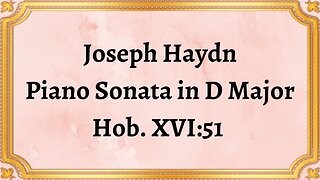Premium Only Content

Wolfgang Amadeus Mozart Piano Concerto №23 in A major, K 488
#Mozart#Chamber_music#Classical_music#Quintet#Musical_composition
Publication date 1931
Mozart Piano Concerto No. 23 in A, K. 488
Arthur Rubinstein with the London Symphony Orchestra conducted by John Barbirolli
Recorded January 8 and 9, 1931, in Kingsway Hall,
Mozart's Piano Concerto No. 23 in A major, K 488, is one of his most famous and beloved works for piano and orchestra. Composed in 1786, it showcases Mozart's extraordinary talent as a composer and his ability to seamlessly blend beautiful melodies with technical virtuosity. In this essay, we will explore the historical context, musical characteristics, and significance of Mozart's Piano Concerto No. 23 in A major, K 488.
Mozart composed the Piano Concerto No. 23 in A major, K 488, during a period of great creativity and productivity. At this time, he was living in Vienna, where he was a sought-after composer and performer. The concerto was written for Mozart's own use, and he premiered it at a concert in Vienna in March 1786. The work was received with great acclaim, and it quickly became one of Mozart's most popular works for piano and orchestra.
Mozart's Piano Concerto No. 23 in A major, K 488, is a beautiful and complex work that showcases his mastery of the piano and his ability to create music that is both technically challenging and emotionally engaging. The concerto is written in three movements, with the first movement marked by a beautiful and expressive melody that is passed between the piano and the orchestra. The second movement is a slow and lyrical Andante, characterized by rich harmonies and delicate melodies. The final movement is a lively and energetic Allegro, which showcases the technical virtuosity of both the pianist and the orchestra.
Mozart's Piano Concerto No. 23 in A major, K 488, is significant for several reasons. First, it is a testament to Mozart's incredible talent as a composer and his ability to seamlessly blend beautiful melodies with technical virtuosity. Second, it is a prime example of the classical concerto form, which was a popular genre in Mozart's time. Finally, it continues to be a beloved and popular work for piano and orchestra, and it is regularly performed and recorded by musicians around the world today.
Mozart's Piano Concerto No. 23 in A major, K 488, is a masterpiece of classical music that continues to captivate audiences around the world today. It is a significant work that showcases Mozart's incredible talent as a composer and his ability to create music that is both technically challenging and emotionally engaging. The concerto is characterized by beautiful melodies, rich harmonies, and technical virtuosity, making it a challenging and rewarding piece for both pianists and orchestras. It is no wonder that Mozart's Piano Concerto No. 23 in A major, K 488, remains one of the most beloved works for piano and orchestra in the classical repertoire.
You have the opportunity to support the channel
https://www.donationalerts.com/r/radsiaral
-
 6:07
6:07
Classical music_Music Inspiration
13 days agoJoseph Haydn Piano Sonata in D Major, Hob. XVI:51
521 -
 LIVE
LIVE
Talk Nerdy 2 Us
2 hours ago🔥 Talk Nerdy 2 Us – Feb 7th: HACKED, TRACKED & UNDER ATTACK! 🔥
159 watching -
 LIVE
LIVE
Man in America
9 hours agoFluoride & the Sinister Plot to Poison Us From Birth w/ Larry Oberheu
459 watching -
 LIVE
LIVE
I_Came_With_Fire_Podcast
9 hours ago🔥USAID SCANDAL | MA-GAZA | Cartel VIOLENCE Ramps Up🔥
73 watching -
 LIVE
LIVE
SpartakusLIVE
3 hours agoShadow BANNED, but we PARTY ON || Friday Night HYPE
434 watching -
 LIVE
LIVE
Omar Elattar
2 hours agoGRANT CARDONE: “Will I Run for Governor?” | Trump EXPOSED | Bitcoin | $500 Billion Crisis!
251 watching -
 46:48
46:48
Glenn Greenwald
5 hours agoGlenn Takes Your Questions On Gaza, USAID, and More | SYSTEM UPDATE #403
46.2K33 -
 56:42
56:42
Candace Show Podcast
8 hours agoBecoming Brigitte: One Coincidence Too Many | Ep 3
117K141 -
 3:14:38
3:14:38
Nerdrotic
9 hours ago $12.62 earnedDisney Plus's Complete FAILURE! Fantastic Four Trailer, MCU Phase 5 Reveal | Friday Night Tights 340
120K30 -
 1:00:58
1:00:58
The StoneZONE with Roger Stone
4 hours agoWill RINOs Sink Robert F. Kennedy Jr.'s Confirmation? | The StoneZONE w/ Roger Stone
19.8K2